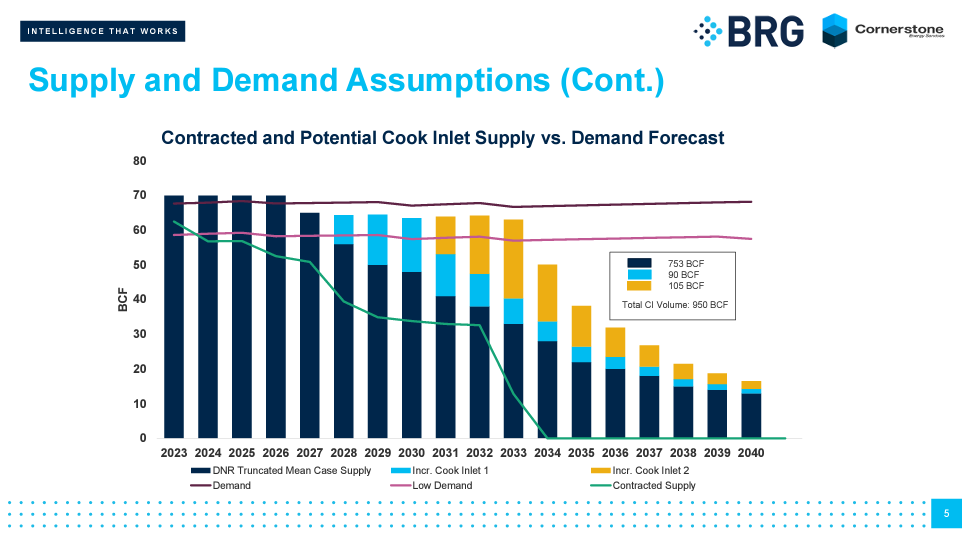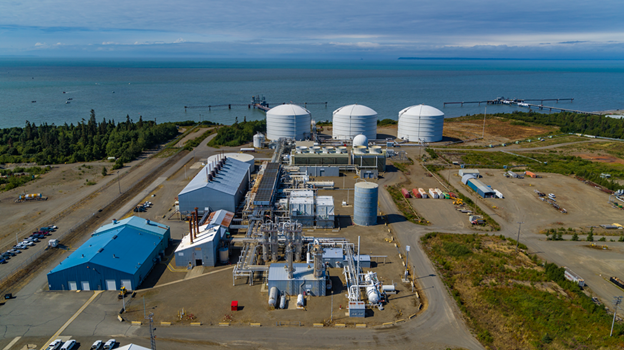The Last Frontier and its abundance of energy resources is once again in the spotlight garnering interest from South Korea, Japan, and Taiwan for investment into its natural gas infrastructure. Alaska has a wealth of natural gas with 35 tcf of proven reserves on the North Slope and another 200 tcf potentially recoverable. The famous 49th State is in an interesting position to add to the already robust U.S. LNG export portfolio, but first needs to avoid a domestic shortage and overcome challenges to make this dream of vast expansion into reality.
Alaska has long relied on the Cook Inlet Basin for its domestic natural gas needs, but a 2023 study showed that the supply of gas was quickly running out and demand would soon outpace supply.

At present, we are only two years away from the original estimate of a potential gas shortage occurring. John Sims, President of ENSTAR (the largest utility company in Southcentral Alaska) reported in January of 2025 on what had been done and what work is continuing to be done to avoid a shortage. This includes expansions of Cook Inlet Natural Gas Storage Alaska (CINGSA), reviewing previous proposals from the 2023 study, submitting proposals to Alaska’s regulatory commission, and entering into agreements with developers for construction of new infrastructure or repurposing of previously existing infrastructure.
There were a variety of options considered to meet the needs of Alaska’s people, but the projects that recently gained renewed interest were repurposing Kenai LNG to become an import terminal and construction of the major Alaska LNG project and associated pipelines.
Kenai LNG
Kenai LNG was an export terminal that was in operation for decades and was a long-time supplier of LNG to Japan. However, it became inactive for a brief period in 2011 due to its lease expiring. In 2014 a lease renewal was granted by the U.S. Department of Energy. This agreement gave, “Authorization to export a quantity of [LNG] in an amount up to the equivalent of 40 billion cubic feet of natural gas on a cumulative basis over a two-year period”. However, after failing to secure deals with importers of LNG, ConcoPhillips made the decision to look to transfer ownership of the facility and succeeded in doing so selling the terminal to Marathon Petroleum in 2018.
The facility remained dormant for several years until a new proposal was made in light of the coming shortage which could befall Alaska. It is now potentially being repurposed into an import facility to assist Alaska in meeting domestic demand.
Harvest Midstream announced in February 2025 that it had entered a partnership with Marathon Petroleum Corporation and Chugach Electric Association to re-purpose the assets located at Kenai LNG. “Under the proposal, Harvest would own, develop and operate the LNG terminal and infrastructure – allowing Chugach, MPC and any other Railbelt customers to secure additional natural gas supplies to help meet the market demand. The project is designed to repurpose existing assets to enable the timely delivery of additional natural gas supplies to the Southcentral market as early as 2026, with full-scale operations beginning as early as 2028.”

Alaska LNG
The Alaska LNG export terminal has been a proposal for nearly ten years that within the last three has gained increasing traction and interest. This terminal would have a total capacity of 20.1 mpta spread amongst three trains and as of now is in pre-FID with start year estimated at 2030. There is also a second important aspect to the viability of this venture which is the Alaska LNG pipeline.
This pipeline effectively runs through the middle of Alaska connecting the abundance of gas in the North Slope to the Alaska LNG terminal which would be located near Anchorage in Nikiski. This massive pipeline would span just over 800 miles and have a capacity between 3500-3900 mcf/d. The pipeline combined with the LNG terminal is expected to cost at least a combined $38.7 billion. It would also have interconnections at different points on its north-to-south journey to provide gas to the Alaskan population spread around the state.

Alaska’s primary focus is thus to first provide gas to meet its own domestic demand; once that need is met it can then begin focusing on exports, which is why this project has seen substantial foreign investment interest and especially from Asia.
Exports to Asia
The United States is currently a top supplier of LNG to Asia with China, South Korea, and Japan (and India by 2030) making up the top importers.

Because all existing U.S. LNG export facilities are located in the Gulf or on the East Coast, Alaska LNG would be uniquely positioned to provide gas to Asia and bypass both the Suez and Panama canals. It would also avoid the need to travel around South Africa’s Cape of Good Hope. Instead, it would be a direct line from Alaska to Asia which would drastically cut down travel time for LNG cargos and lessen associated transportation costs. Because of this, South Korea, Japan, and Taiwan have expressed interest in not only purchasing LNG once the project is completed, but also investing in the project itself and assisting with any associated aspects of the project. The Governor of Alaska, Mike Dunleavy, is even going to be visiting South Korea to further discuss and coordinate efforts related to the project and various South Korean companies that would be involved. The unified goal of all of these countries is to improve the reliability and affordability of LNG coming from the United States and this serves as an opportunity to sign long-term contracts to ensure their energy security needs are met.
How exactly would the market shift if Alaska LNG changed from a pipedream to a pipeline and LNG terminal reality?
RBAC has been part of the Alaskan story, and its Founder and CEO has been modeling the Alaskan dream for over 50 years. So, stay tuned for this story and a deeper analysis in Part 2 of this series to be released in the coming weeks where the GPCM® and G2M2® Natural Gas and LNG Market Simulators will be utilized to show how natural gas from Alaska and Asia’s regional market would likely be impacted and where risks and opportunities may unfold.
Interested in learning about the full capabilities of our natural gas and LNG market simulation tools? Watch the video for more about RBAC and our robust suite of market simulators and click the button below to schedule a free software demonstration.
RBAC is the market leading supplier of global and regional gas and LNG market simulation systems used by the energy industry and related government agencies for over two decades. The GPCM® Market Simulator for North American Gas and LNG™ is the most widely used natural gas market simulation system in North America. RBAC’s G2M2® Market Simulator for Global Gas and LNG™ has been instrumental in understanding evolving global gas and LNG market dynamics and is vital to fully grasp and leverage the interrelationship between the North American and global gas markets.


